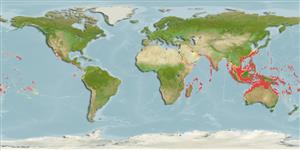Common names from other countries
Classification / Names / Names
Namen | Synonyme | Catalog of Fishes (gen., sp.) | ITIS | CoL | WoRMS
Environment: milieu / climate zone / depth range / distribution range
Ökologie
Pelagisch; tiefenbereich 0 - 200 m (Ref. 83943). Temperate; 45°N - 48°S, 16°E - 175°E
Indo-Pacific.
Length at first maturity / Size / Gewicht / Alter
Maturity: Lm ? range ? - ? cm Max length : 1.8 cm BL Männchen/unbestimmt; (Ref. 3682)
Epipelagic species (Refs. 83943, 116365). Chaetognaths are active carnivores, feeding mostly on copepods, crustacean larvae and other chaetognaths, and occasionally on forams and fish larvae (Ref. 81541).
Life cycle and mating behavior
Geschlechtsreife | Fortpflanzung | Ablaichen | Eier | Fecundity | Larven
Members of the phylum Chaetognatha are hermaphroditic. Mating behavior: A preliminary visual signaling behavior for species recognition is observed to prevent predation. Life cycle: Eggs directly develop into miniature adults (hatchlings).
Pierrot-Bultz, A. 2004. (Ref. 3682)
IUCN Rote Liste Status (Ref. 130435)
CITES Status (Ref. 108899)
Not Evaluated
Not Evaluated
Nutzung durch Menschen
| FishSource |
Tools
Mehr Information
Alter/GrößeWachstumLänge-GewichtLänge-LängeMorphologieLarvenDichte
Internet Quellen
Estimates based on models
Preferred temperature
(Ref.
115969): 21.5 - 28.2, mean 26.5 (based on 414 cells).
Verwundbarkeit
Low vulnerability (10 of 100).
Preiskategorie
Unknown.
